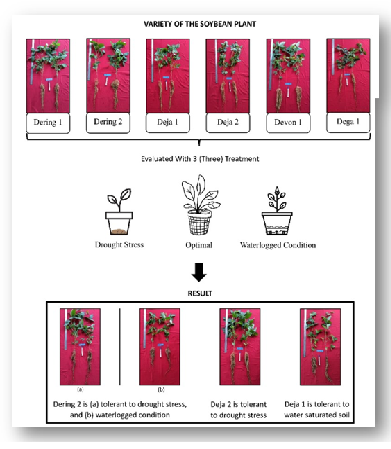Document Type : ORIGINAL RESEARCH ARTICLE
Authors
- Purwantoro .
- R.D. Purwaningrahayu
- H. Kuntyastuti
- A. Harsono
- N. Nuryati
- A. Sulistyo
- Z. Yursak
- R. Soehendi
- Trustinah .
- H. Kuswantoro
- M.J. Mejaya
- D. Harnowo
Research Center for Food Crops, Research Organization for Agriculture and Food, National Research and Innovation Agency, Jl. Raya Jakarta-Bogor 16911, West Java, Indonesia
Abstract
BACKGROUND AND OBJECTIVES: The cultivation of soybeans in Indonesia frequently encounters challenges related to water saturation and drought, which ultimately leads to reduced productivity. The objective of this study was to determine how various soybean varieties react to waterlogging and drought in order to identify soybean cultivars that exhibit tolerance to both types of stressors.
METHODS: The study was conducted at the greenhouse of the Indonesian Legumes and Tuber Crops Research Institute, spanning from June to August 2022. A factorial randomized block design was employed, utilizing pots as the experimental units, with three replicates. The first factor is the availability of groundwater, namely optimal water available (field capacity), 40 percent of field capacity (drought stress), and water-saturated soil (waterlogging stress). The soybean variety is the second factor to consider, which includes Dering 1 (known for its drought tolerance), Dering 2 (also drought tolerant), Deja 1 (tolerant to water saturation), Deja 2 (also tolerant to water saturation), Devon 1 (noted for its high isoflavone content), and Dega 1 (specifically adapted for irrigated lowland conditions).
FINDINGS: The results showed that Dering 2 and Deja 2 varieties grown in soil moisture levels at 40 percent field capacity were capable of achieving similar growth outcomes in terms of plant height, shoot/root ratio, number of pods per plant, seed yield, and 100 seed weight compared to those grown in optimal soil moisture conditions. The stress tolerance index of the two varieties in the soil moisture at 40 percent of field capacity reached 1.03 and 0.83, respectively. The yields of Dering 2 and Deja 2 varieties at the optimal soil moisture reached 4.53 gram per plant and 6.28 gram per plant, and in soil moisture of 40 percent field capacity were 4.68 gram per plant and 5.69 gram per plant respectively. In flooded soil, the Dering 2 and Deja 1 varieties can develop the weight of 100 seeds, number of branches, and plant height as same as in optimal soil moisture, with relatively lower yield reduction compared to other varieties, with stress tolerance index values of 0.66 and 0.54.
CONCLUSION: The Dering 2 and Deja 2 cultivars exhibit tolerance to drought stress levels of up to 40 percent of field capacity, whereas the Dering 2 and Deja 1 cultivars demonstrate tolerance to water-saturated soil. A noteworthy finding is the identification of soybean cultivars capable of thriving in both drought and waterlogged environments, exemplified by the Dering 2 variety. Originally bred to combat drought-related challenges, the Dering 2 cultivar has shown promising results in waterlogged soil conditions as well. Similarly, the Deja 2 variety, which was designed and released for water-saturated environments, was found in this study to be tolerant of drought conditions.
Graphical Abstract
Highlights
- In soil moisture of 40% of field capacity condition, Dering 2 and Deja 2 were able grow better than those grown in the optimal soil moisture;
- In flooded soil, the Dering 2 and Deja 1 varieties can grow better than those grown in the optimal soil moisture;
- The Dering 2 variety, which was developed and released for water-stressed soils, has been found to perform well in water-saturated soils;
- The Deja 2 variety, which was assembled and released for water-saturated environments, was also found to be tolerant of drought conditions.
Keywords
Main Subjects
OPEN ACCESS
©2024 The author(s). This article is licensed under a Creative Commons Attribution 4.0 International License, which permits use, sharing, adaptation, distribution and reproduction in any medium or format, as long as you give appropriate credit to the original author(s) and the source, provide a link to the Creative Commons license, and indicate if changes were made. The images or other third party material in this article are included in the article’s Creative Commons license, unless indicated otherwise in a credit line to the material. If material is not included in the article’s Creative Commons license and your intended use is not permitted by statutory regulation or exceeds the permitted use, you will need to obtain permission directly from the copyright holder. To view a copy of this license, visit:
http://creativecommons.org/licenses/by/4.0/
PUBLISHER NOTE
GJESM Publisher remains neutral concerning jurisdictional claims in published maps and institutional affiliations.
CITATION METRICS & CAPTURES
Google Scholar | Scopus | Web of Science | PlumX Metrics | Altmetrics | Mendeley |
CURRENT PUBLISHER



Letters to Editor
[1] Letters that include statements of statistics, facts, research, or theories should include appropriate references, although more than three are discouraged.
[2] Letters that are personal attacks on an author rather than thoughtful criticism of the author’s ideas will not be considered for publication.
[3] Letters can be no more than 300 words in length.
[4] Letter writers should include a statement at the beginning of the letter stating that it is being submitted either for publication or not.
[5] Anonymous letters will not be considered.
[6] Letter writers must include their city and state of residence or work.
[7] Letters will be edited for clarity and length.
Send comment about this article